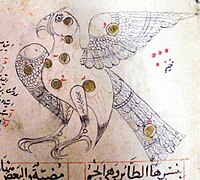Risālat al-Ṣūfī fī al-kawākib

Risālat al-Ṣūfī fī al-kawākib (Arabic:رسالة الصوفي في الكواكب, "Epistle of al-Ṣūfī on the Stars"), is an 10-11th-century poem, probably composed in
urjūza genre.[3]
The text is known from a 13th century manuscript, possibly composed in Baghdad, now in Tehran, Reza Abbasi Museum (RAM M. 570), also called "RAM al'Sufi". It is stylistically dated to circa 1225.[1] An inscription in the manuscript gives a date of AH 554 (1159 CE), but this is probably a later interpolation.[4]
The manuscript has various depictions of the constellations, using various human and animal figures.sharbush headgear.[6]
Another Qajar copy exists, dated ̣to 1894 (Tehran, Majlis Library, no. 5099).[7]
-
Title of Risālat al-Ṣūfī fī al-kawākib
-
Cassiopeia. Ibn al-Ṣūfī, p. 24
-
Centaurus and Lupus. Ibn al-Ṣūfī, p. 72. Centaurus has a Turkicsharbush headgear.[6]
-
Aquila. Ibn al-Ṣūfī, p. 31
-
Ursa Minor. Ibn al-Ṣūfī, p. 5
-
Centaurus (detail) with a Turkicsharbush headgear and clothing.[6]
References
- ^ a b Contadini 2012, Plate 14.
- ^ Contadini 2006, pp. 50–51.
- ^ Contadini 2006.
- ^ Contadini 2006, p. 47: "Given the close relationship of the urjuza miniatures to those in other early-thirteenth-century manuscripts, we would expect the RAM Risalat al-Sufi fi al-kawakib to be datable to ca. 1220-25. It is therefore suprising that on page 4 we find an inscription giving a date of 554 (1159); were this the actual date of the manuscript, it would require a drastic reappraisal of currently accepted views on the chronology of stylistic evolution. There are, however, good reasons for thinking it a later interpolation."
- ^ Contadini 2012, p. 7.
- ^ a b c Contadini 2012, p. 81, "...Centaurus being represented with an elaborate sharbūsh".
- ^ Contadini 2012, p. 172.
Sources
- Contadini, Anna (1 January 2012). A World of Beasts: A Thirteenth-Century Illustrated Arabic Book on Animals (the Kitāb Na‘t al-Ḥayawān) in the Ibn Bakhtīshū‘ Tradition. Brill. .
- Contadini, Anna (2006). "A Question in Arab Painting: The Ibn Al-Sufi Manuscript in Tehran and Its Art-Historical Connections". Muqarnas. 23: 47–84. ISSN 0732-2992.



![Centaurus and Lupus. Ibn al-Ṣūfī, p. 72. Centaurus has a Turkic sharbush headgear.[6]](http://upload.wikimedia.org/wikipedia/commons/thumb/9/9d/Centaurus_and_Lupus._RAM_Ibn_al-%E1%B9%A2%C5%ABf%C4%AB%2C_p._72.jpg/151px-Centaurus_and_Lupus._RAM_Ibn_al-%E1%B9%A2%C5%ABf%C4%AB%2C_p._72.jpg)


![Centaurus (detail) with a Turkic sharbush headgear and clothing.[6]](http://upload.wikimedia.org/wikipedia/commons/thumb/a/a5/Centaurus_and_Lupus._RAM_Ibn_al-%E1%B9%A2%C5%ABf%C4%AB%2C_p._72_%28detail%29.jpg/149px-Centaurus_and_Lupus._RAM_Ibn_al-%E1%B9%A2%C5%ABf%C4%AB%2C_p._72_%28detail%29.jpg)